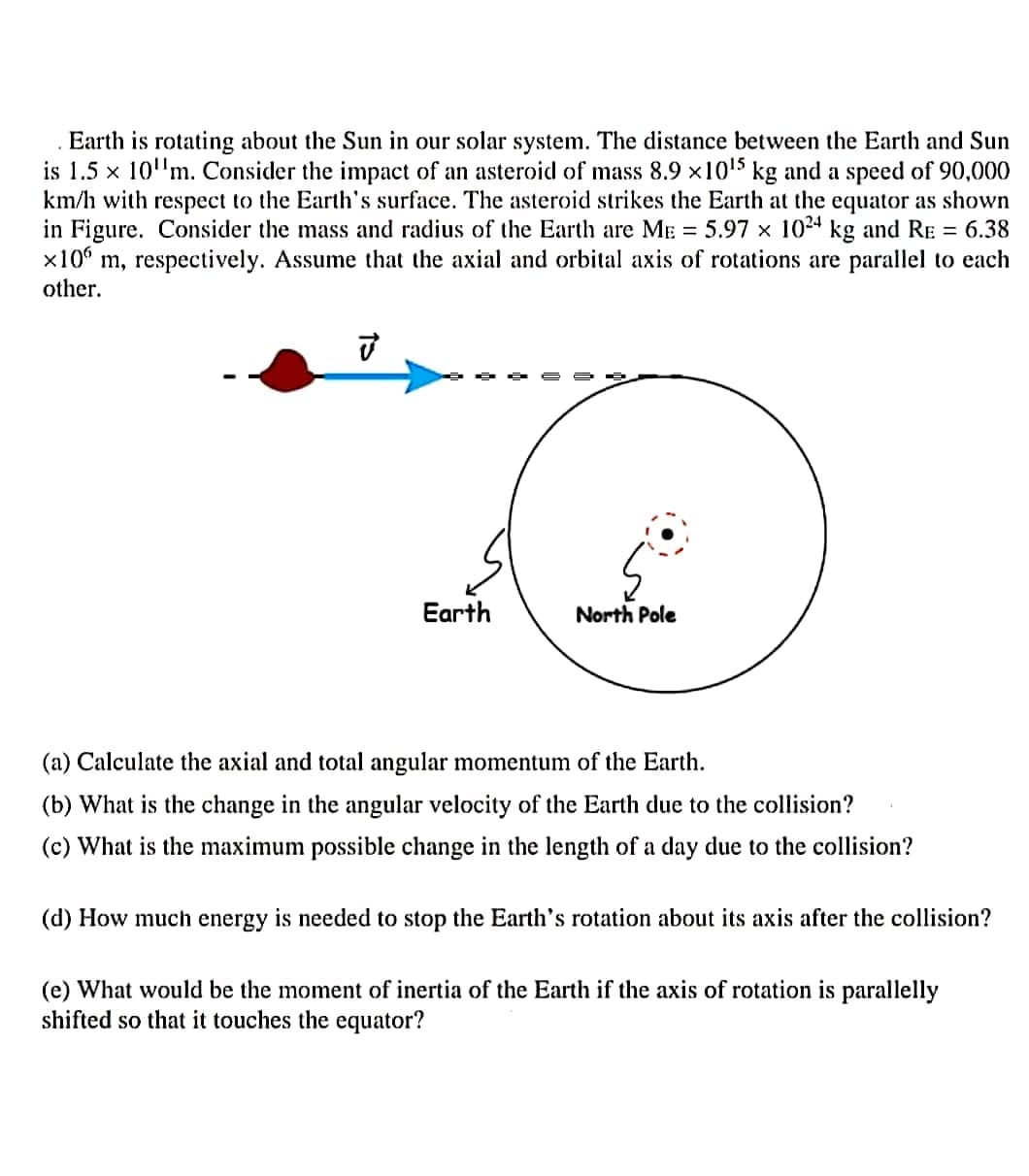Earth is rotating about the Sun in our solar system. The distance between the Earth and Sun is 1.5 x 10"m. Consider the impact of an asteroid of mass 8.9 x1015 kg and a speed of 90,000 km/h with respect to the Earth's surface. The asteroid strikes the Earth at the equator as shown in Figure. Consider the mass and radius of the Earth are ME = 5.97 × 10²4 kg and RE = 6.38 x10 m, respectively. Assume that the axial and orbital axis of rotations are parallel to each other. Earth North Pole (a) Calculate the axial and total angular momentum of the Earth. (b) What is the change in the angular velocity of the Earth due to the collision? (c) What is the maximum possible change in the length of a day due to the collision? (d) How much energy is needed to stop the Earth's rotation about its axis after the collision? (e) What would be the moment of inertia of the Earth if the axis of rotation is parallelly shifted so that it touches the equator?
Earth is rotating about the Sun in our solar system. The distance between the Earth and Sun is 1.5 x 10"m. Consider the impact of an asteroid of mass 8.9 x1015 kg and a speed of 90,000 km/h with respect to the Earth's surface. The asteroid strikes the Earth at the equator as shown in Figure. Consider the mass and radius of the Earth are ME = 5.97 × 10²4 kg and RE = 6.38 x10 m, respectively. Assume that the axial and orbital axis of rotations are parallel to each other. Earth North Pole (a) Calculate the axial and total angular momentum of the Earth. (b) What is the change in the angular velocity of the Earth due to the collision? (c) What is the maximum possible change in the length of a day due to the collision? (d) How much energy is needed to stop the Earth's rotation about its axis after the collision? (e) What would be the moment of inertia of the Earth if the axis of rotation is parallelly shifted so that it touches the equator?
Physics for Scientists and Engineers: Foundations and Connections
1st Edition
ISBN:9781133939146
Author:Katz, Debora M.
Publisher:Katz, Debora M.
Chapter13: Rotation Ii: A Conservation Approach
Section: Chapter Questions
Problem 55PQ
Related questions
Question
Please solve (d) and (e)

Transcribed Image Text:. Earth is rotating about the Sun in our solar system. The distance between the Earth and Sun
is 1.5 x 10'm. Consider the impact of an asteroid of mass 8.9 x1015 kg and a speed of 90,000
km/h with respect to the Earth's surface. The asteroid strikes the Earth at the equator as shown
in Figure. Consider the mass and radius of the Earth are ME = 5.97 x 1024 kg and RE = 6.38
x10 m, respectively. Assume that the axial and orbital axis of rotations are parallel to each
other.
Earth
North Pole
(a) Calculate the axial and total angular momentum of the Earth.
(b) What is the change in the angular velocity of the Earth due to the collision?
(c) What is the maximum
ible change in the length of a day due to the collision?
(d) How much energy is needed to stop the Earth's rotation about its axis after the collision?
(e) What would be the moment of inertia of the Earth if the axis of rotation is parallelly
shifted so that it touches the equator?
た
Expert Solution
This question has been solved!
Explore an expertly crafted, step-by-step solution for a thorough understanding of key concepts.
Step by step
Solved in 3 steps

Knowledge Booster
Learn more about
Need a deep-dive on the concept behind this application? Look no further. Learn more about this topic, physics and related others by exploring similar questions and additional content below.Recommended textbooks for you

Physics for Scientists and Engineers: Foundations…
Physics
ISBN:
9781133939146
Author:
Katz, Debora M.
Publisher:
Cengage Learning

Glencoe Physics: Principles and Problems, Student…
Physics
ISBN:
9780078807213
Author:
Paul W. Zitzewitz
Publisher:
Glencoe/McGraw-Hill

Classical Dynamics of Particles and Systems
Physics
ISBN:
9780534408961
Author:
Stephen T. Thornton, Jerry B. Marion
Publisher:
Cengage Learning

Physics for Scientists and Engineers: Foundations…
Physics
ISBN:
9781133939146
Author:
Katz, Debora M.
Publisher:
Cengage Learning

Glencoe Physics: Principles and Problems, Student…
Physics
ISBN:
9780078807213
Author:
Paul W. Zitzewitz
Publisher:
Glencoe/McGraw-Hill

Classical Dynamics of Particles and Systems
Physics
ISBN:
9780534408961
Author:
Stephen T. Thornton, Jerry B. Marion
Publisher:
Cengage Learning

Principles of Physics: A Calculus-Based Text
Physics
ISBN:
9781133104261
Author:
Raymond A. Serway, John W. Jewett
Publisher:
Cengage Learning

University Physics Volume 1
Physics
ISBN:
9781938168277
Author:
William Moebs, Samuel J. Ling, Jeff Sanny
Publisher:
OpenStax - Rice University

College Physics
Physics
ISBN:
9781285737027
Author:
Raymond A. Serway, Chris Vuille
Publisher:
Cengage Learning